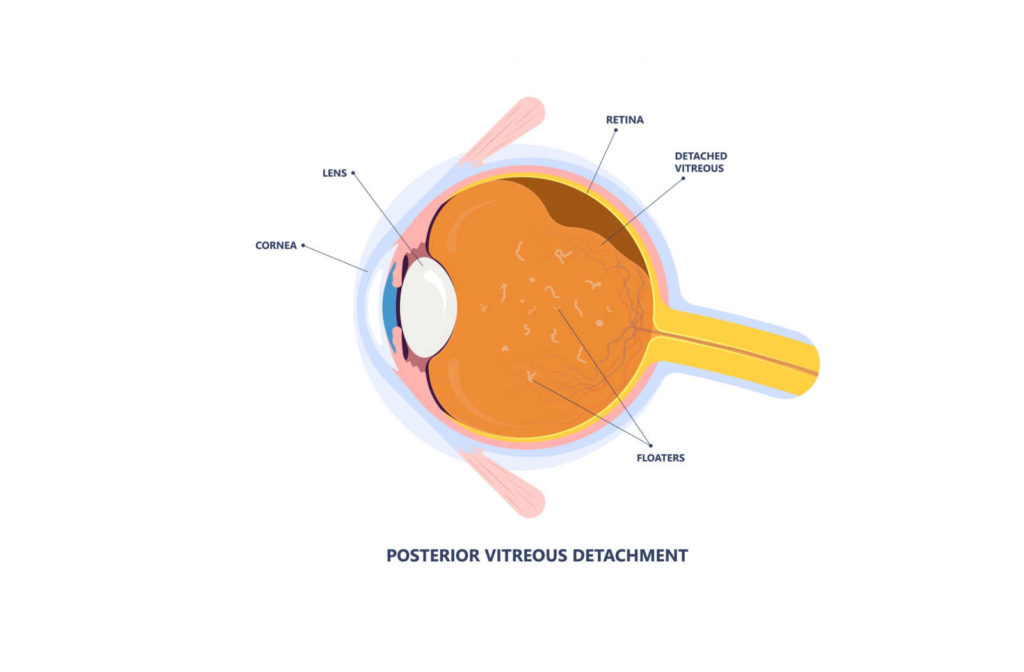Dry eye is a common condition that affects millions of Americans every year. The lack of moisture from insufficient or quality tears can cause burning, itching, or scratchiness in the eyes. Anyone can get dry eye, but you are more at risk if you are 50 and over.
Vitreous detachment, another eye problem, also shares the same risk factor, among others mentioned below. It occurs when tiny fibers in the gel-like fluid (vitreous) in the eye pull away from the retina (the light-sensitive tissue at the back of the eye). Symptoms can include floaters or dark spots in your line of vision.
Even though these conditions are more likely to occur after age 50, there is no link between the two, and dry eye does not cause vitreous detachment.
If you notice signs of dry eye or vitreous detachment, a comprehensive eye exam can help detect these conditions early before it affects your vision.
What Is Dry Eye?
Dry eye is caused by decreased tear production or poor-quality tears. With fewer tears and an imbalance in the tear film (water, mucin, and oil), your eyes lack lubrication, protection, and tears evaporate more quickly.
Causes of tear film dysfunction, decreased tear production, and increased tear evaporation can include:
- Age
- Hormone changes
- Autoimmune disease
- Inflamed eyelid glands
- Allergic eye disease
- Medical conditions
- Certain medications
- Blinking less
- Environmental facotrs
You can experience dry eye in both eyes with discomfort and other symptoms:
- Stinging, burning, or scratchy feeling
- Stringy mucus
- Sensitivity to light
- Redness
- Watery eyes
- Blurry vision
- Difficulty wearing contact lenses
Treatment for Dry Eye
Treatment for dry eye can depend on the severity and the underlying cause. If dry eye is severe and not treated, it can sometimes damage your cornea (the clear outer layer at the front of your eye).
Treatment methods to provide dry eye relief include:
- Eye drops and medications—prescription medication and eye drops are used to treat dry eye inflammation and improve tear reflex.
- Lid spray—hypochlorous lid spray helps fight inflammation, kill bacteria, and open clogged oil glands.
- Eyelid cleansers—helps clean the opening of oil glands to promote healthy tear film.
- Omega-3 supplements—can be taken orally to help produce healthy tear film.
- MiBoFlo—heat applied at a consistent temperature liquefies and dissolves obstructions in the meibomian glands.
- TempSure Envi—radiofrequency energy helps open the meibomian glands to release trapped oils.

What Is Vitreous Detachment?
The eye is filled with a gel-like fluid (vitreous), and tiny fibers attach the vitreous to the retina at the back of the eye. As you age, the vitreous can shrink, and the fibers break, causing it to pull away from the retina, leading to vitreous detachment.
Not all cases of vitreous detachment affect vision, and not everyone notices the symptoms. A common symptom of vitreous detachment is floaters.
Floaters are tiny strands of your vitreous, when clumped together, cast shadows on your retina. These shadows appear as small dark spots, squiggly lines, or cobwebs floating across your field of vision.
It’s normal to see floaters occasionally, but when you suddenly see lots of them, it can indicate vitreous detachment. Other symptoms of vitreous detachment can include:
- Flashes of light in your side (peripheral) vision
- Darkness around the edges of your vision
Treatment for Vitreous Detachment
Vitreous detachment can lead to serious eye conditions, such as a retinal tear and retinal detachment. Retinal detachment is an eye emergency and can lead to vision loss if not treated immediately.
If vitreous detachment doesn’t cause further problems, flashes go away in a week and floaters may become less noticeable after a few months but often do not go away completely. If they are bothersome and make it hard to see, your eye doctor can perform laser treatments which may have limited success and require multiple treatments or a vitrectomy which is a risky procedure and only reserved as a last resort to remove them.
Dry Eye & Vitreous Detachment
The common risk factor shared by dry eye and vitreous detachment is age. Tear production decreases, and vitreous gel shrinks as you age. Besides that, there is no link or indication that dry eye causes vitreous detachment.
You may experience both conditions together as you get older. But contact your eye doctor immediately if you notice:
- Sudden floaters
- An increase in the number of floaters
- Flashes of light
- A dark curtain on the outer edges of your vision
Safeguard Your Vision
Symptoms of dry eye and vitreous detachment can affect your day-to-day life and sometimes even your vision. Dry eye relief from your symptoms is possible with a dry eye evaluation at Signature Eye Care.
Don’t let dry eyes or floaters affect your vision. Let us help you achieve clear and comfortable vision—book an appointment with us today.



